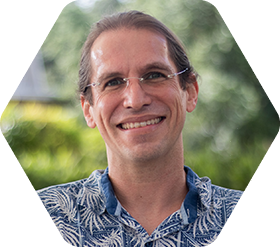Assistant Professor of Biology
Degrees
- Ph.D., Neuroscience, Wake Forest University School of Medicine, September 2011
- M.S., Zoology, North Carolina State University, July 2006
- B.S. Zoology, University of Florida, July 2003
Biography
Defining the mechanisms by which experience is coupled to changes in the chemistry and structure of the brain is a fundamental aim of neuroscience research. My research focuses on linking molecular and structural changes in the brain with changes in behavior. Using insect models that display complex social behaviors (the honey bee and bumble bee), my laboratory studies the impact of environmental stressors on learning and memory.
In collaboration with a colleague at the Honey Bee Research and Nature Center, we are developing an automated bee learning tester. Using a modern approach to a decades-old behavioral test, the lab explores environmental stressors on learning in the developing and adult honey bee. The effects of long-term pesticide exposure and real-world combinations of pesticides will be explored first. Using a marker specific for neuronal synapses, changes in learning will be correlated to changes in brain structure.
The lab also is exploring the effect experience, including learning and pesticide exposure, on brain structure. Using immunohistochemical techniques combined with modern microscopy and image processing, we reconstruct 3-dimensional representations of the mushroom bodies, a multisensory area of insect brain implicated in learning. Changes in synaptic structures are used as a measure of the effect of experience.
Selected publications
- S.E. Dobrin, and S.E. Fahrbach. 2012. Visual associative learning in restrained honey bees
with intact antenna. PLoS ONE 7(6): e37666. doi:10.1371/journal.pone.0037666 - S.E. Dobrin, and S.E. Fahrbach. 2012. Rho GTPase activity in the honey bee mushroom
bodies is correlated with age and foraging experience. J. Insect Physiology. 58(2):228-34. - S.E. Dobrin, J. D. Herlihy, G.E. Robinson, and S.E. Fahrbach. 2011. Muscarinic regulation of
Kenyon cell dendritic arborizations in adult worker honey bees. Arthropod Structure and
Development 40(5):409-19. - S.E. Dobrin and D.E. Wilson. 2010. What’s the buzz about honeybee memory? J.
Neuroscience 30(44):14593-4. - S.E. Fahrbach and S.E. Dobrin. 2009. The how and why of structural plasticity in the adult
honey bee brain. Cognitive Ecology II. Eds. R. Dukas and J. M. Ratcliffe. University of Chicago
Press. Pp 27 – 46.








